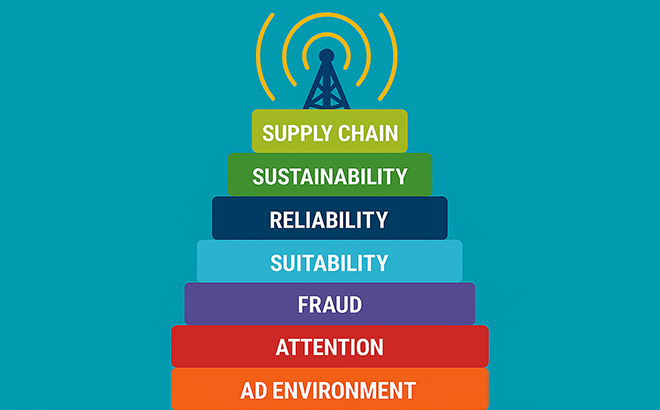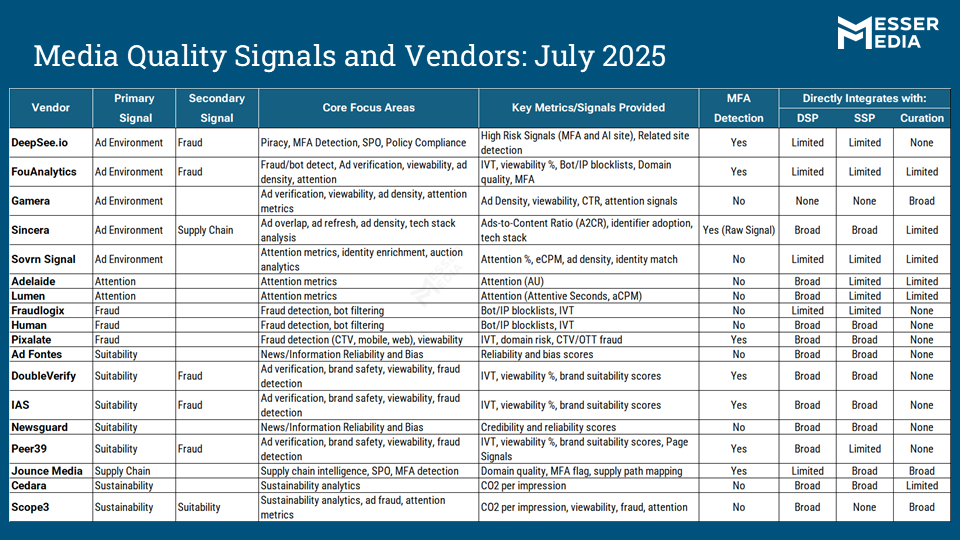
The definition of “media quality” in advertising technology has always been subjective. But today, a wave of objective metrics and how they apply to business processes is reshaping the programmatic landscape.
From Blunt Tools to Granular Signals
We’ve moved beyond the historical model where SSPs performed basic domain-level checks and DSPs handled the rest, often through blunt keyword blocking or post-impression analysis like IVT deductions.
We are in a new era, driven by two major forces: sell-side curation, where inventory is packaged and marketed as premium, and the rise of specialist vendors providing trusted, granular signals directly to the ecosystem. These vendors, like Jounce, Sincera, and Ad Fontes, are moving the entire quality evaluation process pre-bid, and that means fewer auction shenanigans and ultimately a realignment of incentives (towards quality).
The Seven Signals That Matter Now
This shift isn’t just a new feature; it’s a fundamental change in how media is valued and transacted. These new (and old) signals fall into several key categories:
- Ad Environment Metrics: Analyzing the ad environment, including ad-to-content ratio, refresh rate, viewability, and more.
- Attention: A mix of viewability and onsite behavior that “predicts” placement performance
- Fraud: Differentiating between general and sophisticated invalid traffic (GIVT and SIVT)
- Suitability: Matching ad creative to content based on a brand’s specific desires and limits of acceptability
- Reliability: Evaluating the trustworthiness of the content itself
- Sustainability: Measuring the carbon impact and footprint of media delivery
- Supply Chain: A technical look at transaction paths via ads.txt, sellers.json, and SCHAIN
These signals are no longer silent judgments; they have very loud, real-time revenue implications.
A Wake-Up Call from the AdTech Therapist
During a recent AdTech Therapy(™) advisory session, a publisher client was concerned that their CPMs and bid rates were lagging behind competitors. They were confident in their quality, citing a top-10 Comscore category ranking and a belief that IVT wasn’t an issue since they don’t buy traffic.
As the AdTech Therapist, I conducted a quick analysis of their ad environment metrics within Sincera, which revealed a different story. Site-wide viewability averaged just 52%, some ad units were refreshing every 20 seconds, and the ad-to-content ratio was a staggering 65%.
The publisher had no idea this data was visible to their transaction partners, let alone that DSPs and traders were actively shifting budgets away from their supply because of it. Armed with this new understanding, we began the “therapy” process to improve their site, its metrics, and the market’s perception of their inventory.
How Publishers Can Navigate the New Landscape
This publisher’s experience is a clear warning: ignoring these signals is no longer an option. As the accompanying chart of media quality vendors illustrates, the marketplace is a patchwork of players with varying levels of adoption across different platforms. To stay ahead, publishers must be proactive.
- Understand Your Position. Analyze your sales channels and acknowledge your reliance on the open auction, where these filters are most prevalent.
- Engage Your Partners. Talk to your SSPs and the DSPs buying your inventory. Ask them which quality and verification tools they use, how they apply them, and whether they get reporting at the domain level or more granularly.
- Monitor Your Signals. You cannot fix what you do not measure. Keep a close eye on your metrics, especially when making site updates or when a vendor changes a metric’s definition. Many verification vendors offer free access for publishers, which should be standard practice across the industry.
- Be Proactive. Don’t wait for your partners to penalize you. Encourage your team to improve your metrics and set a clear plan for achieving those goals over time.
The new sheriffs in town are media quality signals. While the blunt tools of the past have bludgeoned publishers, this new era of transparent, granular data is a net positive. It provides a clear opportunity for high-quality publishers to differentiate their inventory, command premium value, and help stamp out the budget-munching MFA sites that devalue the entire ecosystem.
Seeing the Signals
To help you navigate this signal-driven landscape, the chart below details the key vendors providing these critical quality solutions. It outlines their primary focus—from Ad Environment to Sustainability—and shows where their data is integrated across the programmatic ecosystem. I have intentionally omitted contextual signals, since that is not “media quality,” and I will update this list as new signals and vendors emerge. This guide serves as a map to the players shaping the future of media valuation.
(Click the image to open or download)
Scott Messer will lead a tactical session to help you diagnose, decode, and improve your performance in the bidstream at AdMonsters Sell Side Summit Nashville, August 17-19, 2025.
